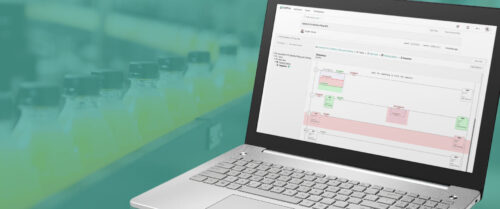Product design: Incorporating commercial technologies into industrial controllers
Industrial controllers are using commercial off-the-shelf (COTS) technologies such as Ethernet, field-programmable gate arrays (FPGAs), USB, and MicroSD cards to improve price/performance ratios, shrink form factors, and add new features.
Programmable logic controllers (PLCs), programable automation controllers (PACs), and other controllers used in industrial automation applications borrow freely from commercial technologies. These technologies are used as is, or modified to meet specific and demanding industrial application requirements.
Commercial-off-the-shelf (COTS) technologies can be used in controllers and other automation components to benefit designers and end users.
Mobile technology leads the way
Mobile technology is a driving factor greatly impacting industrial control system designs. Manufacturers continue to make smartphones, tablets, and other devices ever thinner, smaller, and more powerful. Technologies they use are trickling down into the industrial arena, with many components meeting the specifications required for industrial use, as Figure 1 shows.
A particular area of interest is 3.3 V components. In the past, the required supply voltage at the component level was 5 V or 12 V, but many new components only require 3.3 V. This lowers the power consumption of industrial controllers, and the heat generated.
For example, a fully loaded PLC with advanced power technology consumes only about 15 W. This benefits end users by reducing the cost of the required power supply system, and by cutting the cooling requirements for the enclosure housing the controller.
Computer technology is being applied to improve the price/performance ratio of industrial controllers, while reducing size and power requirements. Compared to years past, onboard memory for commercial devices is greatly expanded. This trend is working its way into industrial automation controllers.
Designers need to pack more memory into smaller areas to handle a variety of applications. About 15 years ago, industrial controllers typically had about 10 kB or 15 kB of onboard memory. This was only enough for executing some ladder logic and a couple of proportional-integral-derivative (PID) analog control loops; even high-end controllers could only run about 16 PID loops.
Now, industrial controllers can not only store all the program code, they also store all the documentation for the project. Also, there is often a separate segment of memory available for storing historical data. Even with all of these needs, there is still enough memory to run more than 100 PID loops.
COTS technology, industrial controls
Some COTS technologies commonly applied in industrial controllers include:
- Ethernet
- USB
- FPGA
- MicroSD.
Ethernet and USB provide benefits to product designers and end users. Ethernet communication is standard on many modern automation controllers, creating an open system for communications with a wide variety of input/output (I/O), field devices, human-machine interfaces (HMIs), higher-level computing systems, and other products.
Users probably reap the benefits of Ethernet more than product designers. Through one port, multiple protocols can be used, which connect to multiple devices and provide programming access. For example, Ethernet can be used to provide communication to multiple EtherNet/IP (from ODVA) and Modbus TCP devices from one port when the controller is connected to an Ethernet switch. Ethernet can also be used to branch out to multiple components by using the features and intelligence built into the protocol.
Using COTS products such as Ethernet connectors, cable, switches, and peripheral devices saves money and simplifies setup and wiring. Every time a new generation of Ethernet is introduced in the commercial arena, it soon migrates into the industrial world, further improving the price/performance ratio.
USB communication is another COTS technology used in modern industrial automation controllers. One of the most important design features of current USB technology, such as USB 2.0 Micro B, is its smaller size. Not only do users gain plug-and-play capabilities, they also have a programming port; all within a small footprint.
Field-programmable gate arrays (FPGAs) are used in some industrial automation controllers as a traffic coordinator for backplane communications. This provides benefits in terms of increased speed, and reduces required space by combining the functions of multiple general-purpose chips into one custom-configured chip.
MicroSD cards provide a low cost and simple way to expand onboard memory. The ability to expand an industrial controller’s memory to store up to 32 GB of historical data on a removable microSD card is a requirement for many applications.
New controller, family design
Many automation vendors offer a variety of controller sizes. It is advantageous when a controller designed for smaller applications is lower cost, while still containing many of the features found on large- and medium-sized PLCs. COTS technologies allow vendors to provide this functionality at a reasonable cost.
With different size controllers in mind, product designers are able to ensure the controller platform’s scalability, and ensure the family of controllers can use the same programming software, simplifying coding for end users.
With a family of controllers, there will always be an overlap of pricing, capabilities, I/O capacity, and other features—with the end game being to provide a better solution. Lower cost and less space are always two of the primary goals for the smallest controller in a product line. Linear DIN-rail space in a control enclosure is prime real-estate because it often drives the size of the enclosure. The more space consumed the higher the cost of the enclosure, so for small PLCs, it is imperative to minimize the required DIN-rail space.
Extra engineering resources
Resource allocation for product design is another consideration; products are more easily designed with teams in multiple locations, such as the U.S. and in Asia. Extra engineering help such as mechanical design, board layout, and some of the firmware work may also be needed for a project. Many firms find partnering can be an effective method for development, as opposed to doing everything in-house (Figure 2).
COTS technology is being used to make industrial automation controllers smaller and more affordable. It allows even small and inexpensive controllers to be used for demanding tasks such as protocol conversion and historical data storage, in addition to performing the main duties of machine and process control.
Jeff Payne is automation controls group product manager, AutomationDirect. Edited by Mark T. Hoske, content manager, Control Engineering, CFE Media, mhoske@cfemedia.com.
KEYWORDS PLC, automation product design
- Commercial-off-the-shelf components help with controller design, low-power use, and communications.
- Planning with a controller family in mind can help with scalability, programming, and ease of use.
- Using an engineering partner can speed automation design and development.
CONSIDER THIS
How can this controller design advice help with your product design?
ONLINE
See Digital Report on PLCs www.controleng.com/DigitalReports
See related New Products for Engineers under the PLC product category at www.controleng.com/NP4E
Do you have experience and expertise with the topics mentioned in this content? You should consider contributing to our CFE Media editorial team and getting the recognition you and your company deserve. Click here to start this process.





